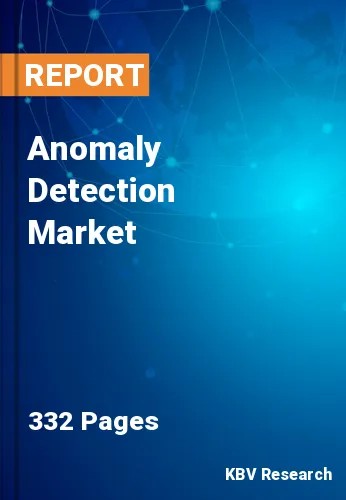The Global Anomaly Detection Market size is expected to reach $13.4 billion by 2030, rising at a market growth of 15.9% CAGR during the forecast period.
The digital economy has swiftly grown throughout the region of Asia Pacific as a result of a strong increase in e-commerce activity, online transactions, and digital services. Consequently, the Asia Pacific region will acquire approximately 1/4th share in the market by 2030. The need for anomaly detection has grown due to this expansion to identify and handle potential fraud, security flaws, and other anomalies in these digital transactions. The regional financial services sector is expanding rapidly because of growing banking services, fintech advancements, and a rise in digital payments. Anomaly detection is crucial for Anti-Money Laundering (AML) initiatives, fraud prevention, and legal compliance in this sector.
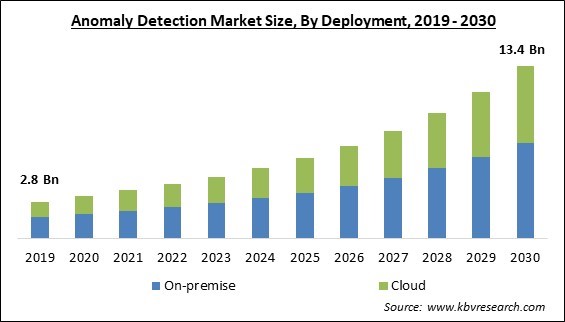
The major strategies followed by the market participants are Partnerships as the key developmental strategy to keep pace with the changing demands of end users. For instance, In June, 20223, Amazon Web Services Inc. expanded its partnership with Lacework Inc. to enhance security alerts and provide its clients an improved anomaly detection linked with Amazon Guard Duty findings. Additionally, In December, 2021, Amazon Web Services, Inc. (AWS), an Amazon.com, Inc. company formed a collaboration with Pfizer, to develop a prototype solution for detecting abnormal data points in its drug product continuous clinical manufacturing platform for solid oral-dose medicines.
Based on the Analysis presented in the KBV Cardinal matrix; Microsoft Corporation is the forerunner in the Market. Companies such as Cisco Systems, Inc., Broadcom, Inc., Dell Technologies, Inc. are some of the key innovators in the Market. In March, 2022, Cisco Systems, Inc teamed up with NetApp to provide the joint customers of the two companies with automation, hybrid cloud operations, and visibility solutions.
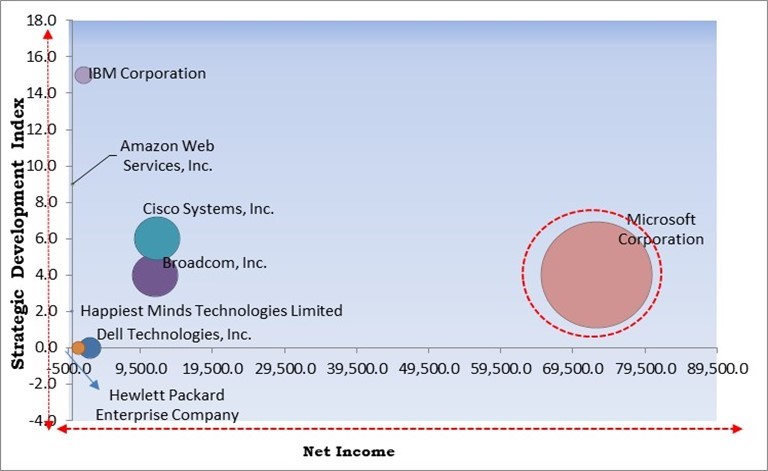
Anomaly detection is becoming increasingly necessary as the number of linked devices is increasing in banking, IT, healthcare, finance, manufacturing, and government & defense. The widespread use of IoT solutions that actively participate in various technological advancements significantly impacts the IoT industry. The market has seen an upsurge due to the increasing use of cloud-based IoT devices, which has increased competition to provide the best solutions to various end-use industries. Moreover, one of the main causes of the IoT industry's enormous development is considerable government attempts to digitalize businesses and sectors.
The ability to detect anomalies has substantially increased because of developments in AI and machine learning techniques. Artificial intelligence (AI) may aid in many ways, including automation, real-time analysis, scrupulosity, accuracy, and self-learning, when human resources are insufficient to handle the adaptable framework of cloud infrastructure, microservices, and containers. One of the greatest benefits of AI systems as well as ML-based solutions, is their ability to learn as they go along and provide better and more accurate results with each iteration. Hence, AI-powered anomaly detection tools can evaluate complicated patterns, adapt to shifting surroundings, and accurately pinpoint anomalies, spurring market expansion.
Anomaly detection systems can be challenging to build and tune to identify true anomalies while avoiding false positives (or false alarms). High rates of false positives could reduce user confidence in the system's accuracy and lead to warning fatigue, which could prevent product uptake. False positive rates that are too high can cause alert fatigue and a lack of faith in the system, whereas false negative rates that are too low can leave serious anomalies unnoticed. For the market to expand, anomaly detection algorithms' accuracy must be improved. Integrating anomaly detection tools with current workflows and systems can be difficult and time-consuming. Implementing anomaly detection technology may be slowed down by organizations facing compatibility problems with legacy systems. Thus, these factors may hamper the market's growth in the coming years.
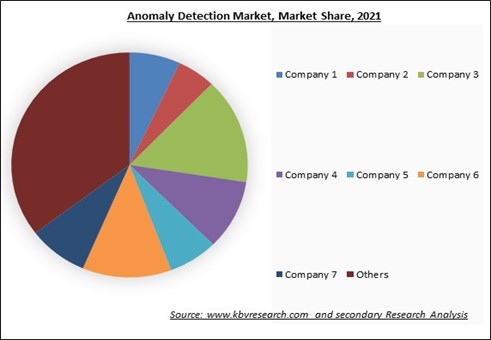
The leading players in the market are competing with diverse innovative offerings to remain competitive in the market. The above illustration shows the percentage of revenue shared by some of the leading companies in the market. The leading players of the market are adopting various strategies in order to cater demand coming from the different industries. The key developmental strategies in the market are Partnerships & Collaborations.
Based on deployment, the market is segmented into cloud and on-premise. The cloud segment acquired a substantial revenue share in the market in 2022. Cloud-based anomaly detection systems are unsurpassed in their adaptability and scalability. Organizations may easily scale up or down anomaly detection capabilities in accordance with their needs because of cloud infrastructure. Because data processing and volume requirements fluctuate over time, organizations don't need to spend much money on infrastructure or plan for capacity with cloud infrastructure.
On the basis of technology, the market is classified into machine learning & artificial intelligence, big data analytics, and business intelligence & data mining. The big data analytics segment recorded the largest revenue share in the market in 2022. As connected devices and digital technology advance, businesses produce and collect large amounts of data from multiple sources. Manually finding irregularities can be challenging because this data is available in both unstructured, structured, and semi-structured, formats.
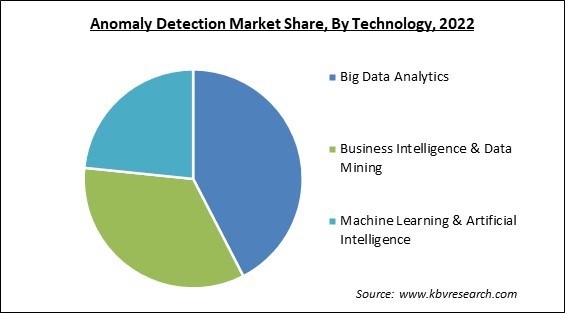
Based on component, the market is bifurcated into solution and services. The services segment procured a considerable growth rate in the market in 2022. Cloud-based security service solutions commonly incorporate anomaly detection services. With the help of these services, enterprises can easily and affordably set up as well as maintain anomaly detection operations.
On the basis of the solution, the market is classified into network behavior and user behavior. The network behavior segment acquired the largest revenue share in the market in 2022. Network behavior analysis is required for the operation of network behavior anomaly detection. Machine learning (ML) and artificial intelligence (AI) are used in network behavior anomaly detection to identify hidden hazards in areas of network infrastructure where other security technologies cannot access them and to alert network personnel.
By end-use, the market is characterized into BFSI, retail, IT & telecom, healthcare, manufacturing, government & defense, and others. The BFSI segment garnered the maximum revenue share in the market in 2022. Risk management is crucial to the BFSI industry. Anomaly detection makes it possible to identify potential risks, including market risk, operational risk, credit risk, and fraud risk. By identifying anomalies in financial transactions, customer behavior, or market patterns, organizations can assess and minimize risks, make intelligent decisions, and prevent financial losses.
| Report Attribute | Details |
|---|---|
| Market size value in 2022 | USD 4.2 Billion |
| Market size forecast in 2030 | USD 13.4 Billion |
| Base Year | 2022 |
| Historical Period | 2019 to 2021 |
| Forecast Period | 2023 to 2030 |
| Revenue Growth Rate | CAGR of 15.9% from 2023 to 2030 |
| Number of Pages | 332 |
| Number of Table | 543 |
| Report coverage | Market Trends, Revenue Estimation and Forecast, Segmentation Analysis, Regional and Country Breakdown, Market Share Analysis, Competitive Landscape, Companies Strategic Developments, Company Profiling |
| Segments covered | Deployment, Technology, Component, End-use, Region |
| Country scope | US, Canada, Mexico, Germany, UK, France, Russia, Spain, Italy, China, Japan, India, South Korea, Singapore, Malaysia, Brazil, Argentina, UAE, Saudi Arabia, South Africa, Nigeria |
| Growth Drivers |
|
| Restraints |
|
Region wise, the market is analyzed across North America, Europe, Asia Pacific, and LAMEA. The North America segment recorded the highest revenue share in the market in 2022. The continent of North America is subject to an unstable environment that is changing quickly, especially regarding cybersecurity. The proliferation of digital technology, along with the development of big data, has also led to huge data production and collection by companies. Anomaly detection is essential for spotting fraudulent activities in the insurance, e-commerce, financial, and healthcare sectors. By monitoring patterns and anomalies in transactional data or user behavior, businesses can proactively identify and lower the risk of fraud.
Free Valuable Insights: Global Anomaly Detection Market size to reach USD 13.4 Billion by 2030
The market research report covers the analysis of key stake holders of the market. Key companies profiled in the report include Amazon Web Services, Inc., Broadcom, Inc., Cisco Systems, Inc., Dell Technologies, Inc., Dynatrace, Inc., Happiest Minds Technologies Limited, Hewlett Packard Enterprise Company, IBM Corporation, Microsoft Corporation and SAS Institute, Inc.
By Deployment
By Technology
By Component
By End-Use
By Geography
The Market size is projected to reach USD 13.4 billion by 2030.
Increasing volume of data and connected devices are driving the Market in coming years, however, Issues with false alarms and system implementation restraints the growth of the Market.
Amazon Web Services, Inc., Broadcom, Inc., Cisco Systems, Inc., Dell Technologies, Inc., Dynatrace, Inc., Happiest Minds Technologies Limited, Hewlett Packard Enterprise Company, IBM Corporation, Microsoft Corporation and SAS Institute, Inc.
The On-premise segment generated the maximum revenue in the Market by Deployment in 2022; thereby, achieving a market value of $7.5 billion by 2030.
The North America region dominated the Market by Region in 2022 and would continue to be a dominant market till 2030; thereby, achieving a market value of $4.2 billion by 2030.
Our team of dedicated experts can provide you with attractive expansion opportunities for your business.
